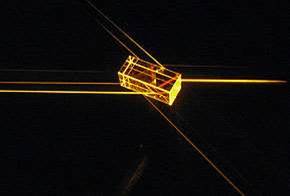Researchers at the Australian National University claim to have slowed light "all the way to a stop" in a cooled, rare-earth crystal that could serve as data storage in future quantum communications.

Using the crystal, which was surrounded in a magnetic field and cooled to -270 degrees Celcius, the researchers "stored" laser light for up to three microseconds with 69 percent efficiency.
This was no small feat, according to lead researcher Morgan Hedges, who noted that light normally would have travelled almost a kilometre in that time.
Once stored within the crystal, information in the light could be manipulated and released as a "three-dimensional hologram" by simply reversing the polarity of the magnetic field.
Hedges declined to specify how much data each crystal would store, noting that the researchers were still wrestling with the nature of information stored, and not the volume of it.
"It's not something we're thinking in terms of at the moment," he told iTnews. "The current application isn't for storing lots and lots of information; it's about storing a different sort."
Hedges expected the storage technique to have applications in research labs, and in quantum encryption, which has been touted as the holy grail of security since it is impossible to eavesdrop on a quantum system without disturbing it.
The technique could also enable long-distance quantum communications networks by acting as a "repeater station", strengthening and ensuring the integrity of a signal along its path.
Hedges said each rare-earth crystal cost around $500, and was cooled to a mere three degrees above absolute zero in a "big thermos" of liquid helium.
He said the method was a significant improvement on current, vapour-based quantum storage methods, which typically achieved efficiencies of less than 17 percent.
The research was published last week in the scientific journal, Nature. The researchers planned to consolidate this work with a 2005 study in which they stored light for 2.3 seconds at a lower efficiency.
Eventually, ANU team leader Matthew Sellars said the team would produce an efficient system with storage times of "hours".
Meanwhile, Hedges aimed to develop a system with more than 70 percent efficiency and storage times of "a few milliseconds" within "the next couple of years".
Photo credit: Australian National University



_(5).jpg&h=140&w=231&c=1&s=0)




.png&w=100&c=1&s=0)

 iTnews Benchmark Security Awards 2025
iTnews Benchmark Security Awards 2025
 Digital Leadership Day Federal
Digital Leadership Day Federal
 Government Cyber Security Showcase Federal
Government Cyber Security Showcase Federal
 Government Innovation Showcase Federal
Government Innovation Showcase Federal
 Digital NSW 2025 Showcase
Digital NSW 2025 Showcase












_(1).jpg&h=140&w=231&c=1&s=0)



